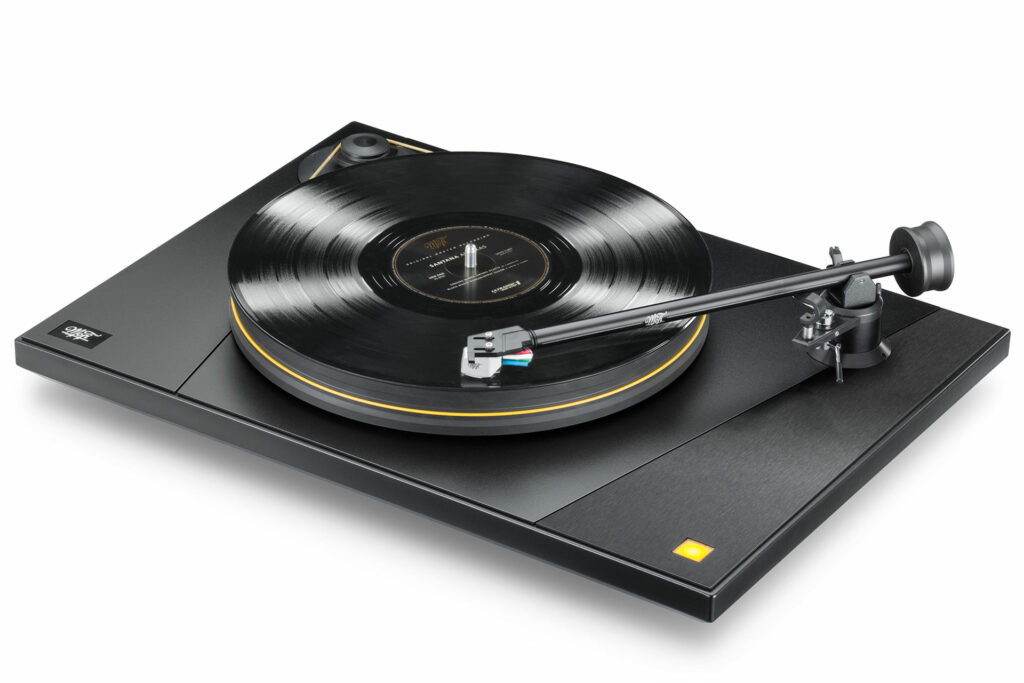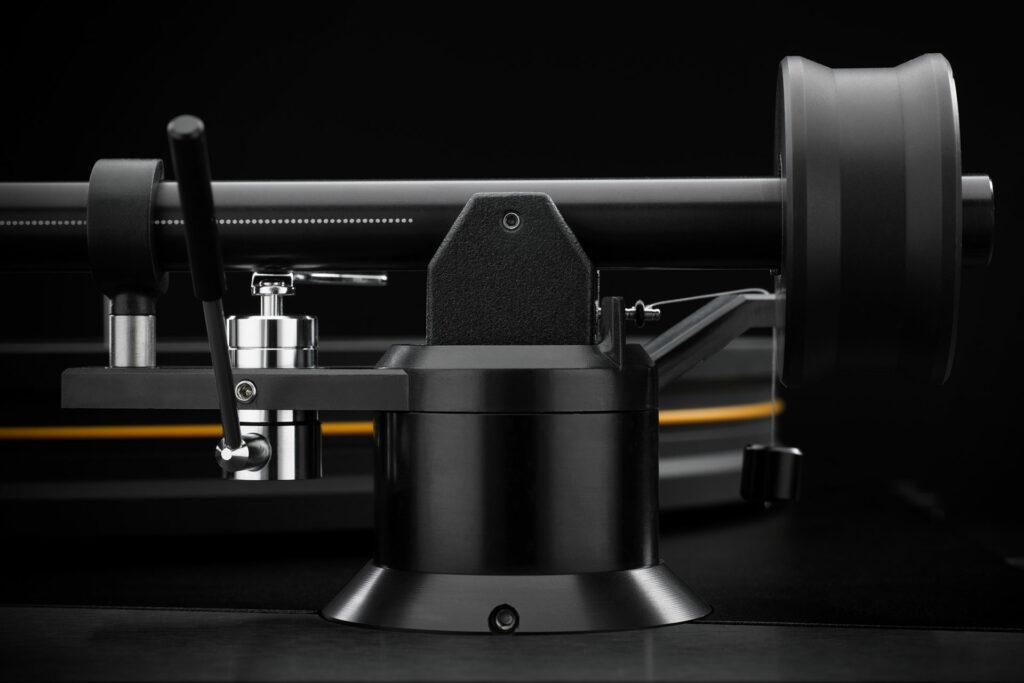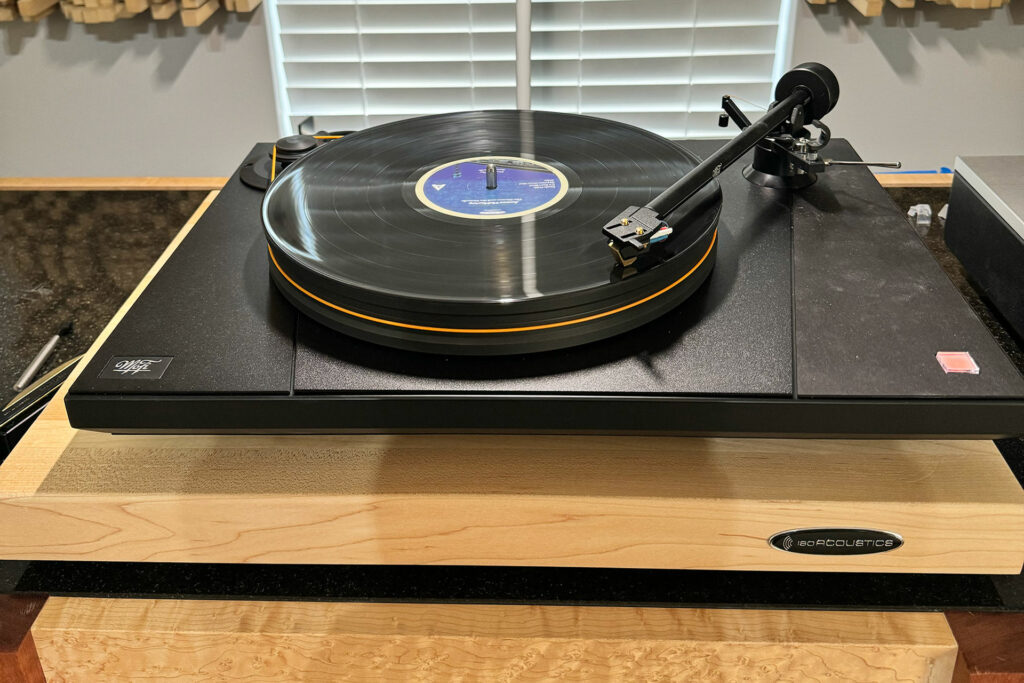Having spent many years producing high-quality remastered LPs, when the newly-established electronics division of Mobile Fidelity decided to manufacture a turntable, a natural segue from recording to source component was born. MoFi Electronics was formed, and today produces turntables, cartridges, phonostages, speakers and a variety of accessories for the audio enthusiast, audiophile and beyond.
MoFi Electronics not only sent a review sample of the magnificent MasterPhono phonostage (read the review here), they also sent me their turntable positioned in the middle of their lineup – the UltraDeck. While the turntable by itself carries a retail price of $2,499, my review sample came with a pre-mounted MoFi UltraGold MC cartridge. Priced alone, the UltraGold MC cartridge retails for $1,495 but, when ordered along with the UltraDeck turntable, the retail price for turntable and cartridge is $3,499. This represents a $495 savings over individual pricing.

A Few Words About Cartridges Used in This Review…
My current go-to cartridge is the Ortofon MC Verismo ($6,999), which may seem a little like overkill for this review. Admittedly, it is quite dynamic, finely detailed, and produces a remarkable soundstage, incredible imaging and excellent bass. It was, therefore, an exceptional benchmark against which the MoFi cartridges might be judged. Compared to the MoFi UltraGold MC ($1,495), itself featuring a boron cantilever and neodymium magnets, it was mostly similar to the Ortofon in retrieval of detail. Imaging and bass were slightly lacking, and I noticed some differences in dynamic capability and slightly reduced overall musicality. However, given the cost difference, none of that comes as a surprise. MoFi also included the StudioSilver MC cartridge ($999) which, like the UltraGold, also features a boron cantilever and neodymium magnets. Sonically, I found it surprisingly similar to the UltraGold MC, so much so that it could be an excellent choice for this turntable in its own right. This is clear evidence that MoFi has developed a group of very worthy, cost-friendly cartridges for their turntable lineup. And best of all, any of them may be pre-mounted at the factory.

What Makes the MoFi UltraDeck Turntable Special?
- Chassis construction consists of three aluminum plates bonded to an MDF base in a constrained layer dampening configuration. This assembly method not only adds mass, a real-world benefit for turntables, but also reduces vibrations and tonal colorations, which may negatively affect sonics and an overall neutral presentation.
- The 6.8-pound platter is 1.3 inches thick and manufactured from DelrinÒ, which from a material standpoint is polymetrically very close to a vinyl LP. MoFi claims this makes an excellent platter to LP impedance match.
- A fully isolated 300 RPM AC synchronous motor drives the platter. This motor is reported to measure as to be exceptionally quiet, owing to the fact it is decoupled from the turntable with advanced dampening materials. This decoupled design also keeps vibrations away from the tonearm and cartridge. I never heard one sound from the motor, whether driving the platter or not.
- A stepped DelrinÒ motor pulley allows the manual selection of a 33.33 RPM and a 45 RPM platter speed. Checking both speeds with a platter speed app found them on the whole quite accurate. On my review sample, the platter speed registered 32.6 RPM, which is slightly slow. Of course, this may be due to variances in the belt and/or the accuracy of the platter speed app. In none of my listening tests did I ever have the feeling the 33.33 RPM speed was slow. To the contrary, everything I played sounded absolutely correct.
- A 10-inch tonearm is supplied with very low friction ball bearings, making overall operation quite smooth and effortless. The tonearm is a gimbaled configuration,n which should please anyone who is not the most ardent fan of a Unipivot design.
- The wiring in the tonearm is an upgraded Cardas Audio cable and runs from the headshell to the gold-plated RCA connectors on the back of the turntable. Having upgraded wiring and gold-plated connectors are both features not commonly found on turntables in this price class.
- One option is to purchase the UltraDeck turntable with one of four MoFi cartridges installed at the factory. While some final assembly is required, having the cartridge mostly pre-mounted streamlines overall setup time.
- Four fully adjustable feet, made by equipment rack manufacturer HRS, provide completely independent adjustment to ensure the turntable is as level as possible. I used a bubble level placed near the spindle and two torpedo levels – one on the front and one on the side.
- I was pleasantly surprised to find a smoke-gray dust cover in the box. It was so well-packaged I almost missed it, which would have been my fault, not MoFi’s.
- An IEC connector on the back of the turntable means a user-supplied power cord may be substituted for the factory-supplied version. For this review, I exclusively used the factory-supplied power cord versus swapping them out with any number of aftermarket ones that I have become fond of over the years.
- This turntable is designed to be simple to set up and operate. Having the cartridge mounted at the factory made things easier and shortened the shipping box to playing an LP time to just under one hour.
Why Should You Care About the MoFi UltraDeck Turntable?
Turntables have come a long way in the last 20 years. They have gone from near-obscurity to an accepted, mainstream part of an audio system. It is now possible to buy a turntable for less than $100 and, depending on your dedication to analog, and your wallet, there are several models priced at $500,000 and those don’t include a tonearm. For most audio systems with an analog capability, the MoFi UltraDeck is a tremendous value. Combining excellent design and features more commonly found on units in a higher price class, this turntable checks off many of the desirability boxes. It is fairly simple to set up and use. It is fabulously well-made and exudes an overall feeling of craftmanship. You can certainly spend more for a turntable. You can spend less. But I highly doubt anyone who does purchase a MoFi UltraDeck will be left with the feeling they made a mistake.

Some Things You Might Not Like About the MoFi UltraDeck Turntable
- Even with a factory-mounted cartridge, it is still necessary to set the VTA, anti-skating, and mount the tonearm counterweight. It will additionally be necessary to set the tracking force. It is also fair to point out these adjustments are necessary because of the excellent packaging, designed to protect the turntable during shipment.
- Vertical Tracking, or VTA, is all manual. A setscrew is loosened, the tonearm height is adjusted with one hand, while the setscrew is retightened with the other hand. I fully realize this design was chosen due to cost constraints, but I would still like to see the more precise dial calibration method to adjust VTA.
- Completely baffling to me is the location of the power switch. On its own, the nicely- sized power button has a professional studio-type feel, an audible “click” sound, and appropriately positive engagement when pressed on or off. Why MoFi decided to place it directly underneath the stylus and cantilever (when at rest) is somewhat confusing to me. This opens the door for damaging, if not ruining, a cartridge by inadvertently hitting it when pressing the power switch. On the newly-introduced MasterDeck, the power button is on the opposite side of the turntable – where it should be.
Listening To the MoFi UltraDeck Turntable…
While a direct comparison to my current turntable, the Luxman PD-151 with the aforementioned Ortofon MC Verismo cartridge, a setup considerably higher in overall cost, may not be the most fair, I nonetheless felt it would be an interesting contrast. Generally speaking, the MoFi UltraDeck with the UltraGold MC cartridge delivered a highly enjoyable listening experience. The composite musicality was fun and engaging. Toe-tapping was a nearly unavoidable physical reaction. There was a real sense of presence on each LP I played. There was an ease and liquidity to the overall presentation. Better recordings really shone and were rendered with impressive sonics. While not as impactful as my Luxman/Ortofon reference, the MoFi setup still managed to provide a visceral sense of dynamics – especially when moving from soft passages to loud ones.
On recordings where the PRaT (Pace, Rhythm and Timing) really got going, I never felt the turntable was in any way lacking. It never missed a step, so to speak. When considering the main attributes of any listening experiencing, among those imaging, dynamics, a black background, musicality and overall enjoyment, the MoFi UltraDeck turntable with the UltraGold MC (and, to a very slightly lesser extent, the MoFi StudioSilver MC cartridge) exceeded my expectations and proved to be a turntable almost any vinyl enthusiast could appreciate.
I already have the CD version of Harry Styles’ 2022 release of Harry’s House, but since I received the LP version as a gift, I thought I would use it as a music selection. The track “Little Freak” begins with a thumping bass drum whack which, on the LP version, sounded very dynamic. Nothing was obviously lost to the CD. Harry’s voice has an almost haunting quality and, again, the LP played on the MoFi UltraDeck held its own in portraying the echo effect on the recording. As this is a mostly soft-sounding track, the presentation was mostly easy and polite.
On the LP version of Daft Punk, Random Access Memories, the entire work is riddled with electronica. The opening track “Give Life Back To Music” has been described as being about less is more. The intro is pretty much just that, an intro. But the electronic effects when the vocals begin give testament to how innovative this track and LP really are. While it is not for absolute certain which of the French pair who comprise the band actually contributed the robotic-styled vocals, the effects done with a vocoder are nonetheless magnificent. This track is effectively a cross between electronic synthesizers and acoustic music, and the detail brought about by the MoFi UltraDeck gives a clear separation between both. Put this LP on, crank it up and you will almost certainly feel your feet begin to move.
Will the MoFi UltraDeck Hold its Value?
Turntables have become somewhat of a hot commodity in recent years. Prices range from very inexpensive to as much as a buy-a-modest-home-expensive. Models range from something carried with one arm to something moved with a forklift. MoFi chose to play in a very crowded field, specifically the $2,500 price class. And not surprisingly, there are quite a few contenders.
Considering, however, the list of features, how well made the MoFi UltraDeck is for the cost, the ability to utilize a factory-made-and-mounted cartridge or use your own, the IEC outlet allowing the use of a user-supplied power cord, upgraded wiring and gold-plated RCA terminals, MoFi has delivered a strong-performing audiophile product at a very fair price. Combining real-world value, excellent sonics, and a legacy of analog experience, the resale value is excellent. In fact, I looked and only found one UltraDeck listed used. However, it had already been sold and was no longer available. It sold in a little over two weeks and at about 50 percent of the retail price. So does the MoFi UltraDeck hold its value? Absolutely. Finding none for sale used is an extremely positive harbinger of a product with better than average resale prospects.

Who Is the Competition for the MoFi UltraDeck Turntable?
Wow, this may easily be a veritable dog fight of a comparison. There are many brands and models that might legitimately be considered a competitor to the UltraDeck. Let’s look at a few.
Stalwart manufacturer Pro-Ject has two offerings, one, the Pro-Ject RPM 5 Carbon (buy at Crutchfield), at a retail price of $2,199, is a very popular turntable from a highly-regarded brand. The Pro-Ject RPM 5 uses an acrylic platter mounted on an inverted bearing with a ceramic ball. The arm tube is made from carbon fiber. It is available, like MoFi, with or without a factory-mounted cartridge.
Slightly more expensive is the Pro-Ject 6 PerspeX SB at a retail cost of $2,799. This very well-made turntable utilizes an inverted bearing with a stainless steel axle carrying a ceramic plate bearing. The arm tube is carbon fiber, and the platter is a sandwich construction of MDF and a 4mm flat ground vinyl layer, which claims to provide resonance optimization. Again, like MoFi, the 6 PerspeX SB offers a factory-mounted cartridge, an included dust cover and a record clamp. It also has a transparent acrylic plinth, which is something some buyers will like, while others will not. This plinth has a magnetic sub chassis, which is supposed to dissipate the potential noise resulting from a spring or conventionally-mounted chassis.
Lastly is the slightly less expensive Rega Planar 6, at a retail cost of $1,895. The plinth of the Planar 6 is a foam core design, sandwiched between a high-pressure laminate – essentially a constrained layer dampening configuration. This design follows Rega’s basic philosophy, stating rigid, lightweight plinths transmit far fewer vibrations and resonances than do the heavy, massive versions. The platter is a one-piece machined aluminum design, driven by a 24-volt low-noise motor. A factory-mounted cartridge is also available.
Final Thoughts on the MoFi UltraDeck Turntable…
I had an absolutely great time listening to my favorite LPs on the MoFi UltraDeck turntable. The sound quality was excellent, with superior dynamics and, on well-recorded LPs, the overall presentation was magnificent. I would categorize this as an ability to render a level of sonics that belies the turntable’s retail price. There was a real sense of ease and effortlessness in LP after LP I played.
It is also important to consider the simplicity of setup relative to cost. I have seen several turntables cost more, be more difficult to assemble, and yet have sonics ranging from equal to actually not as enjoyable. In my view, MoFi has created a highly listenable turntable at a very fair price. It should also be noted that, when paired with the MoFi MasterPhono, sonics improved even more.
The user may choose a factory-mounted cartridge or one of their own. They may use their own power cord or the factory-supplied version. And whichever tonearm cable is used, it will be connected to gold-plated terminals and upgraded wiring in the arm tube – all at a price point of $2,499 (minus cartridge). “Fun, engaging, energetic and a superior listening experience” are all notes from my listening session, and that sums it up well for my thoughts on the MoFi UltraDeck turntable.




Publisher’s note:
We updated the images on this article on 3/28 to reflect the correct turntable. Sorry for any confusion there on the site or in our email newsletter.